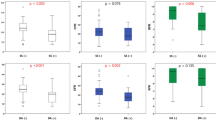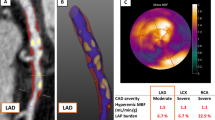Abstract
Purpose
The aim of this study was to analyse non-invasively the regional effect of therapy with an HMG-CoA reductase inhibitor on myocardial blood flow in patients with coronary artery disease (CAD) with special reference to segments with initially substantially impaired vasodilation.
Methods
The study included 26 patients with untreated hypercholesterolaemia. Coronary angiography revealed CAD in nine patients with stenosis >50% and wall irregularities or minimal stenosis <30% in 17 patients. Before and 4.6±1.8 months after atorvastatin therapy, 13N-ammonia positron emission tomography (PET) studies were performed at rest and under pharmacological stress. Minimum coronary vascular resistance (MCR) and coronary flow reserve (CFR) were determined. Segments were divided into those with normal or near-normal (MBF during adenosine ≥2.0 ml/min/g) and those with abnormal (MBF<2.0 ml/min/g) vasodilator flow response. In CAD patients, 156 segments were analysed, 85 of which had abnormal MBF; in the non-obstructive group, 59 of 297 segments had abnormal MBF.
Results
LDL cholesterol decreased after atorvastatin therapy from 186±43 mg/dl to 101±26 mg/dl (p<0.001). In normal segments no significant changes in MBF, CFR and MCR were found. However, initially abnormal segments showed significant improvements in MCR (15%, p<0.0001) and MBF during adenosine (30%, p<0.0001) after therapy.
Conclusion
The improvement in regional coronary vasodilator function after atorvastatin in patients with coronary atherosclerosis may be caused, at least in part, by increased flow-mediated (endothelium-dependent) dilation of the total arteriolar and arterial vascular system. These data further support the concept of non-invasive management of stable CAD by statin therapy and life-style modification guided by PET.


Similar content being viewed by others
References
Ludmer PL, Selwyn AP, Shook TL, Wayne RR, Mudge GH, Alexander RW, et al. Paradoxical vasoconstriction induced by acetylcholine in atherosclerotic coronary arteries. N Engl J Med 1986;315:1046–51
Zeiher A, Drexler H, Wollschläger H, Just H. Endothelial dysfunction of the coronary microvasculature is associated with impaired coronary blood flow regulation in patients with early atherosclerosis. Circulation 1991;84:1984–92
Zeiher AM, Krause T, Schächinger V, Minners J, Moser E. Impaired endothelium-dependent vasodilation of coronary resistance vessels is associated with exercise-induced myocardial ischemia. Circulation 1995;91:2345–52
Schächinger V, Britten MB, Zeiher AM. Prognostic impact of coronary vasodilator dysfunction on adverse long-term outcome of coronary heart disease. Circulation 2000;101:1899–906
Uren NG, Marraccini P, Gistri R, De Silva R, Camici PG. Altered coronary vasodilator reserve and metabolism in myocardium subtended by normal arteries in patients with coronary artery disease. J Am Coll Cardiol 1993;22:650–8
Penny WF, Rockman H, Long J, Bhargava V, Carrigan K, Ibriham A, et al. Heterogeneity of vasomotor response to acetylcholine along the human coronary artery. J Am Coll Cardiol 1995;25:1046–55
Anderson TJ, Meredith IT, Yeung AC, Frei B, Selwyn AP, Ganz P. The effect of cholesterol-lowering and antioxidant therapy on endothelium-dependent coronary vasomotion. N Engl J Med 1995;3312:488–93
Baller D, Notohamiprodjo G, Gleichmann U, Holzinger J, Weise R, Lehmann J. Improvement in coronary flow reserve determined by positron emission tomography after 6 months of cholesterol-lowering therapy in patients with early stages of coronary atherosclerosis. Circulation 1999;99:2871–5
Yokohama I, Inoue Y, Moritan T, Ohtomo K, Nagai R. Impaired myocardial vasodilation during hyperaemic stress is improved by simvastatin but not by pravastatin in patients with hypercholesterolemia. Eur Heart J 2004;25:671–9
Janatuinen T, Laaksonen R, Vesalainen R, Raitakari O, Lehtimaki T, Nuutila P, et al. Effect of lipid-lowering therapy with pravastatin on myocardial blood flow in young mildly hypercholesterolemic adults. J Cardiovasc Pharmacol 2001;38:561–8
Campeau L. Grading of angina pectoris. Circulation 1975;54:522–3
van den Hoff J, Burchert W. Functional polar maps and 3D visualization. In: Hör G, Krause BJ, Tillmans HH, eds. Cardiological nuclear medicine [in German]. Landsberg, Germany: EcomedVerlag, 1997:102–204
van den Hoff J, Burchert W, Wolpers HG, Meyer GJ, Hundeshagen H. Visualization and quantification of three- dimensional myocardial wall motion with PET. Eur J Nucl Med 1996;23:1235
van den Hoff J, Burchert W, Börner AR, Fricke H, Kühnel G, Meyer GJ, et al. [1–11C]Acetate as a quantitative perfusion tracer in myocardial PET. J Nucl Med 2001;42:1174–82
Hutchins GD, Schwaiger M, Rosenspire KC, Krivokapich J, Schelbert H, Kuhl DE. Noninvasive quantification of regional blood flow in the human heart using N-13 ammonia and dynamic positron emission tomography imaging. J Am Coll Cardiol 1990;15:1032–42
Imaging guidelines for nuclear cardiology procedures, part 2. American Society of Nuclear Cardiology. J Nucl Cardiol 1999;6:G47–84
Huggins GS, Pasternak RC, Alpert NM, Fischman AJ, Gewirtz H. Effects of short-term treatment of hyperlipidemia on coronary vasodilator function and myocardial perfusion in regions having substantial impairment of baseline dilator reserve. Circulation 1998;98:1291–6
Gewirtz H, Skopicki HA, Abraham SA, Castano H, Dinsmore RE, Alpert NM, et al. Quantitative PET measurements of regional myocardial blood flow: observations in humans with ischemic heart disease. Cardiology 1997;88:62–70
Dayanikli F, Grambow D, Muzik O, Mosca L, Rubenfire M, Schwaiger M. Early detection of abnormal coronary flow reserve in asymptomatic men at high risk for coronary artery disease using positron emission tomography. Circulation 1994;90:808–17
Hoffmann JIE. Maximal coronary flow and the concept of coronary vascular reserve. Circulation 1984;70:153–73
Baller D, Sigmund-Duchanova H, Zipfel J, Hellige G. Prediction of myocardial blood flow by DPTI and prediction of the adequacy of myocardial O2 supply by the DPTI/STTI ratio under maximal coronary dilation. Basic Res Cardiol 1979;74:378–88
Gould KL, Martucci JP, Goldberg DI, Hess MJ, Edens RP, Latifi R, et al. Short-term cholesterol lowering decreases size and severity of perfusion abnormalities by positron emission tomography after dipyridamole in patients with coronary artery disease. A potential noninvasive marker of healing coronary endothelium. Circulation 1994;89:1530–8
Guethlin M, Kasel AM, Coppenrath K, Ziegler S, Delius W, Schwaiger M. Delayed response of myocardial flow reserve to lipid-lowering therapy with fluvastatin. Circulation 1999;99:475–81
Wolfrum S, Jensen KS, Liao JK. Endothelium-dependent effects of statins. Arterioscler Thromb Vasc Biol 2003;23:729–36
Egashira K, Hirooka Y, Kai H, Sugimachi M, Suzuki S, Inou T, et al. Reduction in serum cholesterol with pravastatin improves endothelium-dependent coronary vasomotion in patients with hypercholesterolemia. Circulation 1994;89:2519–24
Böttcher M, Bötker HE, Sonne H, Nielsen TT, Czernin J. Endothelium-dependent and -independent perfusion reserve and the effect of l-arginine on myocardial perfusion in patients with syndrome X. Circulation 1999;99:1795–801
Vita JA, Treasure CB, Nabel EG, McLenachan JM, Fish RD, Yeung AC, et al. Coronary vasomotor response to acetylcholine relates to risk factors for coronary artery disease. Circulation 1990;81:491–7
Gould KL, Ornish D, Kirkeeide R, Brown S, Stuart Y, Buchi M, et al. Improved stenosis geometry by quantitative coronary arteriography after vigorous risk factor modification. Am J Cardiol 1992;69:845–53
Bassenge E, Heusch G. Endothelial and neuro-humoral control of coronary blood flow in health and disease. Rev Physiol Biochem Pharmacol 1990;116:77–165
Gould KL, Ornish D, Scherwitz L, Brown S, Edens RP, Hess MJ, et al. Changes in myocardial perfusion abnormalities by positron emission tomography after long-term, intense risk factor modification. JAMA 1995;274:894–901
Hambrecht R, Wolf A, Gielen S, Linke A, Hofer J, Erbs S, et al. Effect of exercise on coronary endothelial function in patients with coronary artery disease. N Engl J Med 2000;342:454–60
Buus NH, Bottcher M, Hermansen F, Sander M, Nielsen TT, Mulvany MJ. Influence of nitric oxide synthase and adrenergic inhibition on adenosine-induced myocardial hyperemia. Circulation 2001;104:2305–10
Muzik O, Beanlands R, Hutchins GD, Mangner TJ, Nguyen N, Schwaiger M. Validation of nitrogen-13-ammonia tracer kinetic model for quantification of myocardial blood flow using PET. J Nucl Med 1993;34:83–91
Baller D, Wielepp P, Pulawski E, Holzinger J, Weise R, Notohamiprodjo G, et al. Increase and normalization of coronary dilator capacity upon statin therapy in early atherosclerosis assessed with PET (Petichor trial). J Nucl Cardiol 2003;10:S1
Sech SM, Montoya JD, Bernier PA, Barnboym E, Brown S, Gregory A, et al. The so-called “placebo effect” in benign prostatic hyperplasia treatment trials represents partially a conditional regression to the mean induced by censoring. Urology 1998;51:242–50
Nees S. Coronary flow increases induced by adenosine and adenine nucleotides are mediated by the coronary endothelium: a new principle of the regulation of coronary flow. Eur Heart J 1989;10 Suppl F:28–35
Zanzinger J, Bassenge E. Coronary vasodilation to acetylcholine, adenosine and bradykinin in dogs: effects of inhibition of NO-synthesis and captopril. Eur Heart J 1993;14 Suppl 1:164–8
Smits P, Williams SB, Lipson DE, Banitt P, Rongen GA, Creager MA. Endothelial release of nitric oxide contributes to the vasodilator effect of adenosine in humans. Circulation 1995;92:2135–44
Campisi R, DiCarli MF. Assessment of coronary flow reserve and microcirculation: a clinical perspective. J Nucl Cardiol 2004;11:3–11
Acknowledgements
The authors thank the members of the radiopharmacy unit for preparation of the PET tracer. Furthermore, we thank the technical assistants of the PET group for their excellent collaboration. The study was supported in part by a national research grant from the E.B. Grimmke Heart Foundation, Düsseldorf, Germany, and in part by an unrestricted scientific grant from Pfizer.
Author information
Authors and Affiliations
Corresponding author
Additional information
P. Wielepp and D. Baller contributed equally to the study
Rights and permissions
About this article
Cite this article
Wielepp, P., Baller, D., Gleichmann, U. et al. Beneficial effects of atorvastatin on myocardial regions with initially low vasodilatory capacity at various stages of coronary artery disease. Eur J Nucl Med Mol Imaging 32, 1371–1377 (2005). https://doi.org/10.1007/s00259-005-1828-6
Received:
Accepted:
Published:
Issue Date:
DOI: https://doi.org/10.1007/s00259-005-1828-6




